GNOME 3 Hurts Linux
My Laptop and Fedora 15
I killed my laptop through experimentation. Nothing's wrong with the hardware, but I accidentally obliterated the kernel and bootloader of the Fedora 12 system it was running. I could have booted off a live CD, restored the bootloader, and booted of my backup kernel, but Fedora 15 is out. The laptop was mostly hacks at this point anyway, so I thought I'd upgrade.
My PC runs Fedora 14. I could have used that, but I was curious. I use GNOME as my desktop environment, and Fedora 15 would be my first experience with the new GNOME 3. I haven't heard good things, but people always complain when things change. When Microsoft Office 2007 changed it's menu system to the ribbon, people complained. I thought it was a genius idea, enough to get me to say I like MS Office 2007 more than my beloved OpenOffice.org. Sure, it took a little getting used to, but I like the idea of organizing everything by workflow rather than a gigantic menu that shoved all of those unrelated things together coupled with screen-hogging toolbars.
I assumed GNOME 3 would be to GNOME 2 what Office 2007 was to Office 2003. I was both right and wrong.
The Right Part
GNOME 3 gets rid of panels. Instead, it has applets than run on the desktop background similar to Yahoo! Widgets. (Does that even exist anymore? Last time I tried that, it was still the non-Yahoo! Konfabulator.) This was a little frustrating. I like to have my CPU load, free RAM, and other statistics in the corner of my screen. I can't do that anymore.
The applications menu went from Office 2007 to Office 203. It now overlays the whole screen when selected. That was when I realized what GNOME 3 is trying to be: a smartphone. The more I used GNOME 3 on my laptop, the more it felt like an Android table with a keyboard. "Fine," I thought. "This is probably the way all operating systems are going to go. I'll just have to get used this now."
Although there are still multiple desktops, you must go up and down now to move from desktop to desktop. Left and right or a grid is no longer an option. Also, you don't set the number of desktops you have. The bottom desktop is always empty. If any window is put there, another blank desktop is added to the bottom again. It's not my preference; I usually assign my desktops certain functions, e.g. when writing an article Desktop 1 is always Nautilus (GNOME's file explorer, like when you double-click "My Computer" in Windows), Desktop 2 is always GIMP for photo editing, Desktop 3 is always a Firefox window used for article research and picture gathering, and Desktop 4 is always a Firefox window with my article editor. But, the new ways seems like a good, logical idea. I would get used to it.
Finally, the weird part was that there is no "Shut Down" menu option, only "Suspend." I had to look it up. You have hold a key (I believe it's Alt), and "Suspend" becomes "Shut Down."
The Wrong Part
Why I Use Linux in the First Place
I like using Linux because I know what I'm doing and I like full control over my computer. There are no forced auto-updates that occur in the background while I'm trying to compile something. I'm not going to get assaulted with pop-up notifications in the middle of what I'm doing. If there's something I want done differently, I make it do it differently. But, if you're the kind of person who likes the "normal" way of doing things, you have that option, too. GNOME 3 won't satisfy either of us.
The problem is that, for the most part, Linux is for power users. If you know how to use it, it'll work well for you. If you don't know how to use it, you'll break it. There are (usually) no "Are you sure?" confirmations. You told it what to do, so it will do what you said. Other operating systems assume that you're a moron and prevent you from doing things.
As an example, I'm going show the difference between Ubuntu 11.04 and Windows XP. Why these two? Honestly, it because I already have virtual machines for both of them. However, it's worth pointing out that Ubuntu is the most user friendly of all Linux distributions. It even calls itself "Linux for Human Beings." Ubuntu's desktop environment is GNOME 2. Naturally, Windows XP's desktop environment is Windows XP. Both these tests were done using accounts with admin privileges.
| Ubuntu | Windows XP |
|---|---|
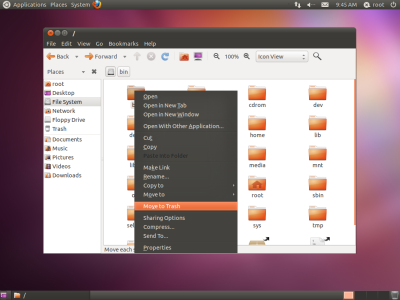 I'm about to click "Move to Trash" on the /bin folder. The mouse pointer is missing because I'm taking a screenshot of a virtual machine. | 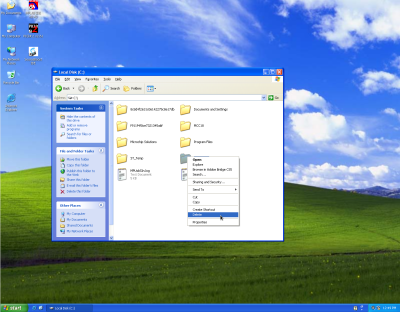 I'm about to click "Delete" on the WINDOWS folder. |
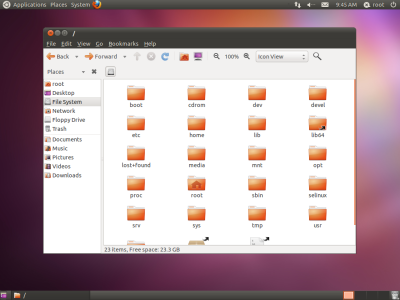 After that single click, the /bin folder is gone. This system is PWNED! | 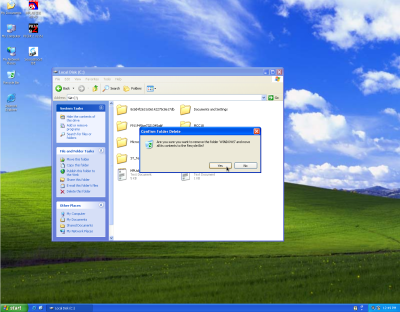 "Are you sure you want to do what you said you wanted to do, or are you a dumbass?" |
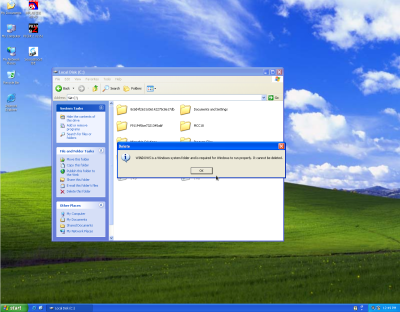 Windows prevents babies from hurting themselves. | |
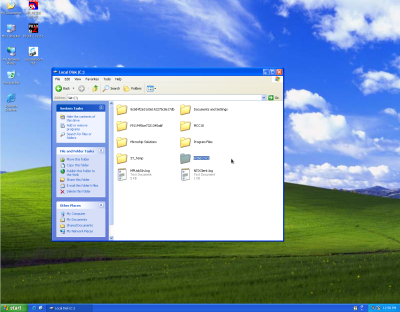 The WINDOWS folder is still there. | |
 All that's left to do is cry for your bottle while the adults get things done. |
Is everyone offended yet?
I'm not picking on non-Linux users because I think they're stupid. I don't think anybody is completely satisfied with the way software is becoming. It's just accepted now. Everything tries to protect the users from themselves, so users never learn what they did wrong in the first place. It encourages bad habits. MS Office automatically fixes incorrect spelling, so when you have to write the word with a pen, you don't know that you're still spelling it wrong.
I was trying to find a good example to demonstrate this when I stumbled upon this blog post.
As I have pointed out before, passwords can be tricky things. For something iek your e-mail account, you need a decent password. So now if Hotmail will reject your password because it's shit, that good right? Well, yes and no. It does stop dictionary attacks, however it drastically changes the search space.
Previously, an attacker would run dictionary attacks in the hope that somebody was a fool. Now that cannot happen then the system is foolproof right? Yes, but to quote Douglas Adams "A common mistake that people make when trying to design something completely foolproof is to underestimate the ingenuity of complete fools." It may sound a touch misanthropic, but people are stupid.
Eventually what is going to happen is that people will find that people will find the least complex passwords that pass through the Hotmail filter and then use those passwords repeatedly. Now dictionary based attacks kick in again, just with a new dictionary. The dictionaries may be larger than previously, but it may not be a significant amount.
Although Mr. Kakvi and I have different opinions on whether or not protecting users from themselves is a good thing, we agree that it's done poorly. He believes that it can be done better; I believe that no computer can account for every mistake. Eventually you will mess up, and if the computer always protected you, you won't have any experience to know how to fix the blunder.
Back to GNOME 3
GNOME 3 has decided that it knows what's best for me. It doesn't.
After installing an operating system, the first things I usually do are:
- Set up any extra hardware
- Set up the network
- Download and install any operating system patches
- Customize the interface
- Install software
Step three usually takes a while, but it doesn't need any user interaction. I simply go to a command line and type yum upgrade and let the laptop do its thing. I decided to watch a movie during the process, so I shut the lid to turn off the screen.
As it turns out, closing the laptop puts the laptop to sleep, which disconnects any network connections and pauses any processes. "Fine," I thought. "I'll just change that power setting and try again." The problem is that it can't be changed! It needs to be done through a hack.
I didn't know about the hack when I did all of this. The solution wasn't as widespread as it is now. I don't shut the lid to my laptop while it's running that often, so I just made sure the laptop was never closed. Over time, GNOME 3 became more and more frustrating until I stopped developing on it at all. My system's resources were being used for fancy window transitions and other pointless graphical crap rather than doing actual work. It was too slow to do anything, so the laptop evolved into a really big netbook.
Also, whenever I downloaded anything, I couldn't minimize Firefox and double-click my home folder icon to see it. GNOME 3 doesn't allow icons or files on the desktop.
The final straw came because I follow Jamie Zawinski's blog. When he posted that he created a bouncing Companion Cube screen saver, I had to have it. The laptop could afford to burn resources now, and the lid was always open anyway. I haven't used one since I used Windows 3.1. Why not install a screen saver?
Because I can't install a screen saver, that's why. Seriously!? The new "desktop" environment can't have a screensaver? No. I'm done. When my actual netbook can do more than my pseudo-netbook, it's time to fix this.
My livelihood depends on my Fedora 14 PC. I'm so glad that I chose to test Fedora 15 on my laptop before upgrading my true development box/personal server.
I'm Not the Only One
I thought about switching to KDE. After all, I build my projects using the Qt library a lot. Even Linux Torvalds prefers KDE over GNOME, right?
Linus Torvalds
I personally just encourage people to switch to KDE.
This "users are idiots, and are confused by functionality" mentality of Gnome is a disease. If you think your users are idiots, only idiots will use it. I don't use Gnome, because in striving to be simple, it has long since reached the point where it simply doesn't do what I need it to do.
Please, just tell people to use KDE.
As I've stated above, I completely agree with that philosophy. But, that was in December 2005. In 2009, Torvalds didn't like the direction KDE was going and switched back to GNOME.
So, when Linux kernel hacker Dave Jones posted about updating to the Linux 3.0 kernel, Torvalds made a request.
Dave Jones
One for my Linux peoples.
Working on an update kernel for Fedora 15, rebasing from 2.6.38 to 3.0.As we know a bunch of userspace packages need updating to deal with the 2.6 -> 3.x transition, we made a decision to ship 3.0, but call it 2.6.40 rather than ship a ton of updates, and risk breaking other code that we don't ship.
I look forward to the "OMG, RED HAT FORKS LINUX" posts on slashdot.
Linus Torvalds
While you are at it, could you also fork gnome, and support a gnome-2 environment?
I want my sane interfaces back. I have yet to meet anybody who likes the unholy mess that is gnome-3.
What's the alternative, then? The only other environment that comes to mind is the ancient Xfce, but that would never happen.
Linus Torvalds
it's not that I have rendering problems with gnome3 (although I do have those too), it's that the user experience of Gnome3 even without rendering problems is unacceptable.
Why can't I have shortcuts on my desktop? Why can't I have the expose functionality? Wobbly windows? Why does anybody sane think that it's a good idea to have that "go to the crazy 'activities'" menu mode?
I used to be upset when gnome developers decided it was "too complicated" for the user to remap some mouse buttons. In gnome3, the developers have apparently decided that it's "too complicated" to actually do real work on your desktop, and have decided to make it really annoying to do.
Here's an example of "the crazy": you want a new terminal window. So you go to "activities" and press the "terminal" thing that you've made part of your normal desktop thing (but why can't I just have it on the desktop, instead of in that insane "activities" mode?). What happens? Nothing. It brings your existing terminal to the forefront.
That's just crazy crap. Now I need to use Shift-Control-N in an old terminal to bring up a new one. Yeah, that's a real user experience improvement. Sure.
I'm sure there are other ways, but that's just an example of the kind of "head up the arse" behavior of gnome3. Seriously. I have been asking other developers about gnome3, they all think it's crazy.
I'm using Xfce. I think it's a step down from gnome2, but it's a huge step up from gnome3. Really.
I agree. GNOME 3 really is that bad. Linux, the power user OS, is becoming increasingly difficult to actually do things with. Linux desktop environments are going backwards, leaning toward the oversimplified yet simultaneously bloated interfaces to attempt to achieve popularity. I understand the appeal of trying to draw in the common user, but don't forget who actually uses Linux. It should not be difficult to make software for Linux while using Linux. Terrible environments like GNOME 3 slow Linux development and work in general. They should be avoided.
I'm going back to GNOME 2.
